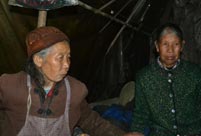

SOUND DEVELOPMENT PATH
Reviewing Tibet's history, the white paper notes that the region first began to embrace modern civilization only after the People's Republic of China was founded in 1949.
Having gone through such important phases as peaceful liberation, democratic reform, the establishment of Tibet Autonomous Region, and the introduction of reform policies and opening up, Tibet has not only established a new social system, but also witnessed a great leap forward in its economy and embarked on the path of socialism with Chinese characteristics.
While following this path, people in Tibet have become masters of their country and their society, and critically, masters of their own destiny, the white paper says.
"The current path of Tibet is an inevitable choice," said Zhalo, a research fellow with the Institute of Modern History, Chinese Academy of Social Sciences. "Today's Tibet proves that choice to have been right."
The majority of Tibetans have been lifted out of poverty and now enjoy relatively comfortable lives.
In 2013, the gross regional product (GRP) of Tibet was 80.77 billion yuan (13.15 billion U.S. dollars) while the per capita net income of rural Tibetans was 6,578 yuan and the per capita disposable income of urban residents was 20,023 yuan.
Tibet's population rose to 3.12 million in 2013, tripling the figures of the early 1950s. Average life expectancy has doubled to 68.2 years.
VENEER OF PEACE, NON-VIOLENCE
The white paper presents evidence to prove that the Dalai Lama and his supporters continued to employ violence to promote Tibetan independence.
During the armed rebellion in Tibet in the late 1950s, the United StatesCentral Intelligence Agency (CIA) not only sent agents to help the 14th Dalai Lama flee Tibet but also trained militants to support his forces and airdropped a large quantity of weaponry.
Since the 1980s, the Dalai Lama and his supporters have been linked to a series of violent incidents in Tibet, including an incident on March 5, 1988, that led to 299 police and civilian casualties, and another on March 14, 2008, in which 18 people were burnt or hacked to death, and 382 injured.
Since 2011, they have incited Tibetan lamas and lay followers inside China to engage in acts of self-immolation.
"For the Dalai party, 'peace' and 'non-violence' are no more than fig leaves," the white paper says.
THE BEST SOLUTION
Since the Dalai Lama fled abroad in 1959, the central government has exercised great restraint and strived for the best solutions.
"However, he [the Dalai Lama] has repeatedly made choices counter to the wishes of the central government and the people of Tibet," the paper says.
The central government received 13 visits by private representatives of the 14th Dalai Lama between 1979 and 2002, and ten visits from 2002 to January 2010.
In 2011, the Dalai Lama announced his "political retirement", and his private representatives who had liaised with the central government also "resigned".
Since then, the Dalai group has declared that it would only talk with the central government in the name of the "government-in-exile", thereby, destroying any basis for contact and negotiation, the white paper says.
 |
 J-11 fighters in air exercise
J-11 fighters in air exercise Beauties dancing on the rings
Beauties dancing on the rings Attendants-to-be join Mr. & Miss Campus Contest
Attendants-to-be join Mr. & Miss Campus Contest Beijing's toughest anti-smoking law takes effect
Beijing's toughest anti-smoking law takes effect Family lives in cave for about 50 years in SW China
Family lives in cave for about 50 years in SW China PLA soldiers operating vehicle-mounted guns in drill
PLA soldiers operating vehicle-mounted guns in drill Blind carpenter in E China's Jiangxi
Blind carpenter in E China's Jiangxi China hosts overseas disaster relief exercise for the first time
China hosts overseas disaster relief exercise for the first time 20 pairs of twins who will become flight attendants in Sichuan
20 pairs of twins who will become flight attendants in Sichuan Obama is sowing discontent in S.China Sea
Obama is sowing discontent in S.China Sea Rescuers work through night to reach cruise ship survivors
Rescuers work through night to reach cruise ship survivors Driving through limbo
Driving through limbo Facing down MERS
Facing down MERSDay|Week